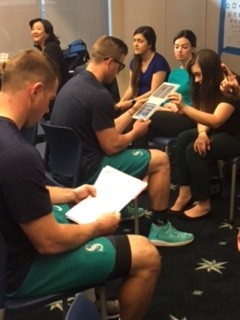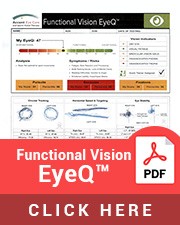It is not uncommon to predict the performance of athletes based on a visual screening test. If you are an athlete and are finding that your improvement has halted, there may be a visual problem limiting your success. Visual therapy for sports vision can unleash your true athletic potential by correcting issues associated with poor or limited eyesight. The training we offer in Arizona for sports vision therapy will get you back in the game again.
Eric Sogard -professional baseball second baseman and shortstop for the Tampa Bay Rays of Major League Baseball. Previously, Eric played for the Milwaukee Brewers, Oakland Athletics, and Toronto Blue Jays.
Eric was gracious enough to allow us to take a picture with a bat and baseball he gifted us years ago, when he was with the Milwaukee Brewers. Eric has been instrumental in encouraging our young patients to continue Vision Therapy. He recently gave a baseball card to one of our VT patients whose family drives here from Tucson ( 2 hour drive one way). Eric is so down to earth, he posed with the thank you card he received from this same VT patient. At one of Eric’s visits to our office, he met with another of our VT patients whose performance in sports was being affected by visual disturbances.
We have wonderful patients!
We have done several screenings at the Seattle Mariners Clubhouse
Why Do Athletes Need a Quiet Eye for Success?
From BBC Future
If anyone knows how to grab a victory from the jaws of defeat, it’s Serena Williams. Just consider her semi-final against Kim Clijsters at the 2003 Australian Open. At 5-2 down in the final set, she was within a hair’s breadth of losing her place in the tournament. But rather than slipping into despair, she saved two match points before winning the next five games. Somehow, each serve and each return landed just where she wanted them to – and she would ultimately go on to win the whole tournament.
A single such feat would be an exceptional occurrence in any career, but Williams has since made similarly breath-taking comebacks at the Australian Open in 2005, at Wimbledon in 2009, and at the China Open in 2014, managing to pull back even when her opponents are serving a match point. In each case, the extreme pressure, rather than causing her to crumble, only seemed to sharpen her concentration.
Over 80% of what we learn comes from the visual system. When performing in a sports-related activity, that percentage goes up even higher because the eyes direct the dynamic movement of the body. Studies have shown that the best performers have the best visual systems. Statistics taken at the Olympic and Junior Olympic level show that those athletes that medaled where those that had the best visual systems. However, other astonishing statistics include the fact that:
- 30% had less than 20/20 vision
- 25% had decreased depth perception
- 26% had poor eye-hand coordination for the demands of their sport
- 12% had inaccurate eye movement abilities (tracking and able to keep their eyes on the ball)
- Visualization – painting a picture in your head of yourself performing a sports activity is just as important as you actually performing the activity. Visualization aids in greater focus on your goals.
- Eye hand coordination-the speed and accuracy of the visually guided hand responses to a rapidly changing target.
- Multiple object capture to track the movement of multiple objects at the same time.
- Reaction time to be able to respond to get the desired result efficiently.
Having visual difficulties in any of the areas above will translate into difficulties in the sport. If you’re looking for sports vision therapy in Arizona, all of these areas can be improved through a prescribed program conducted at our Phoenix office. For more information, go to www.COVD.org

















 powerhousegroup.net
powerhousegroup.net